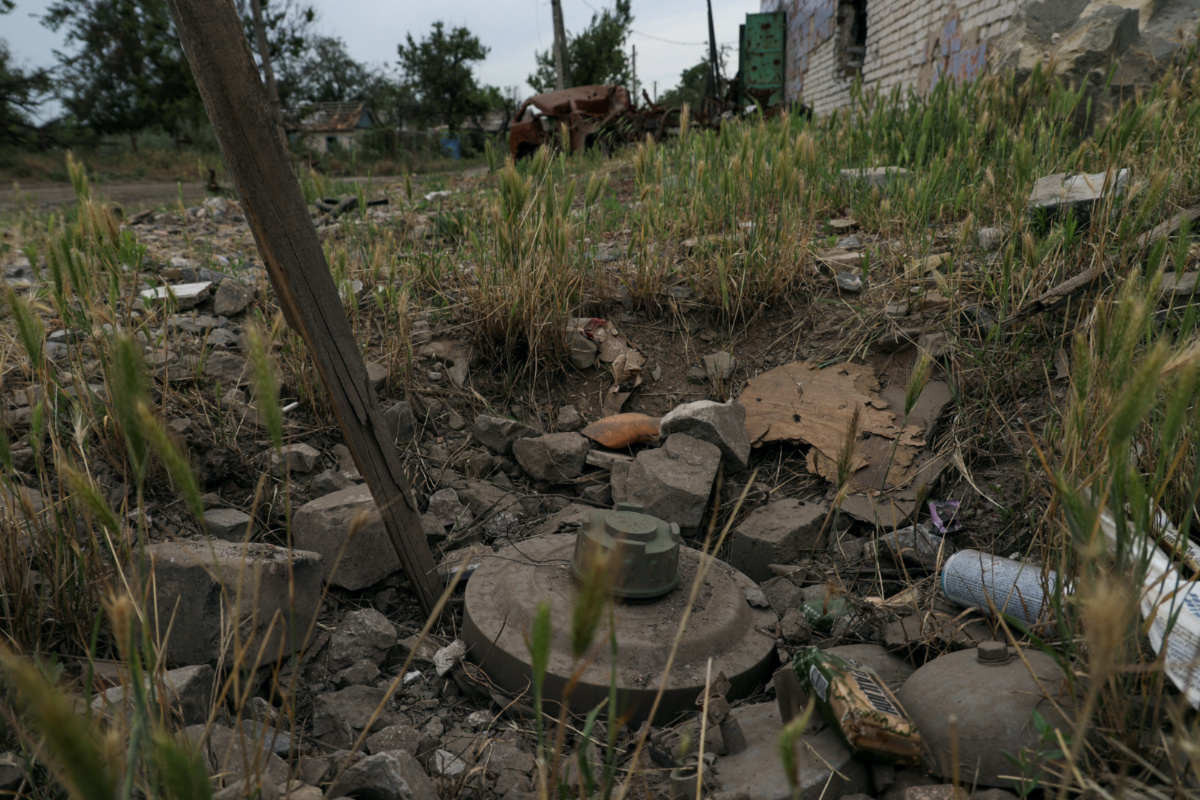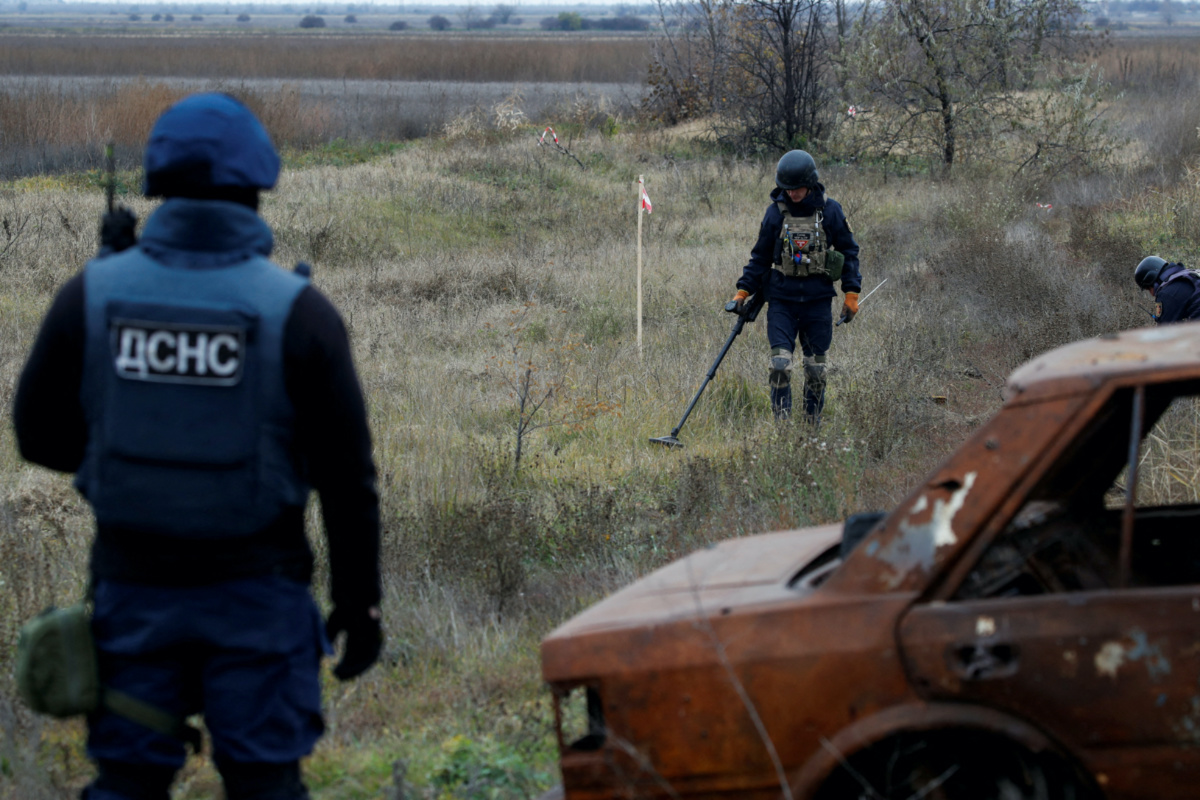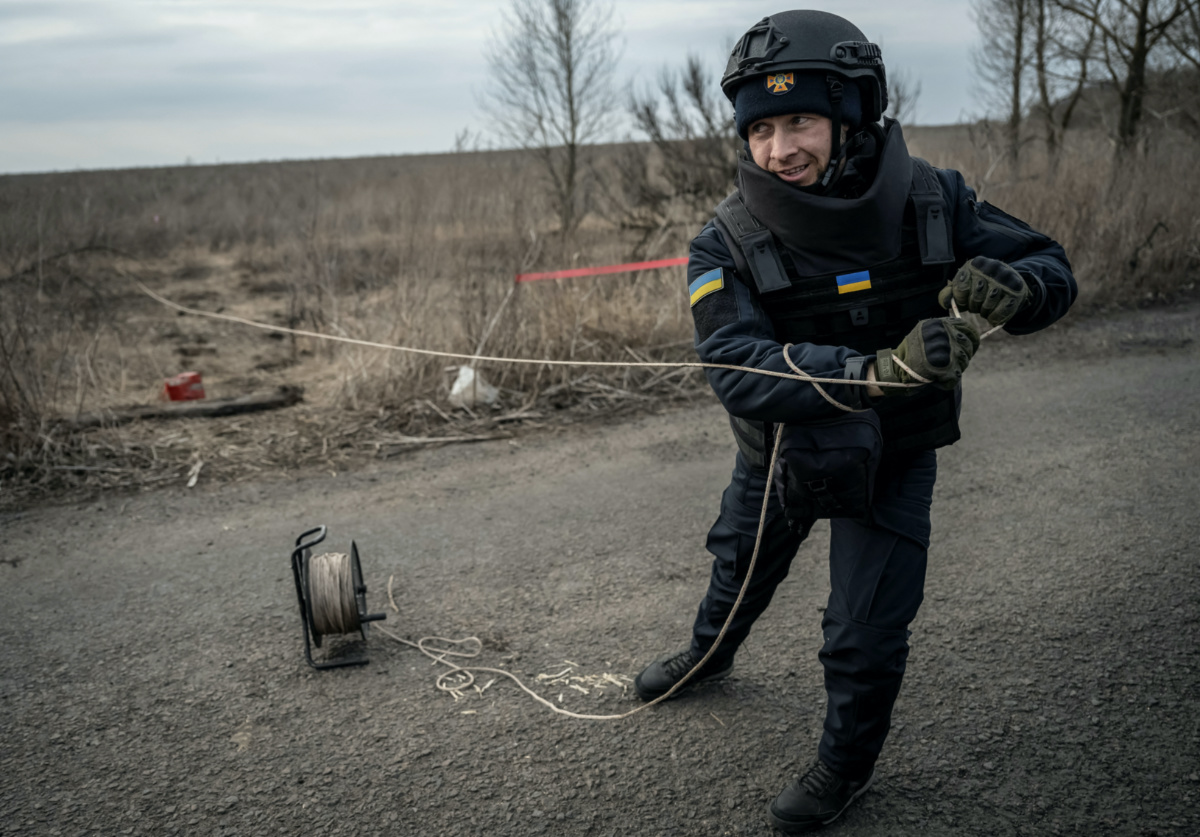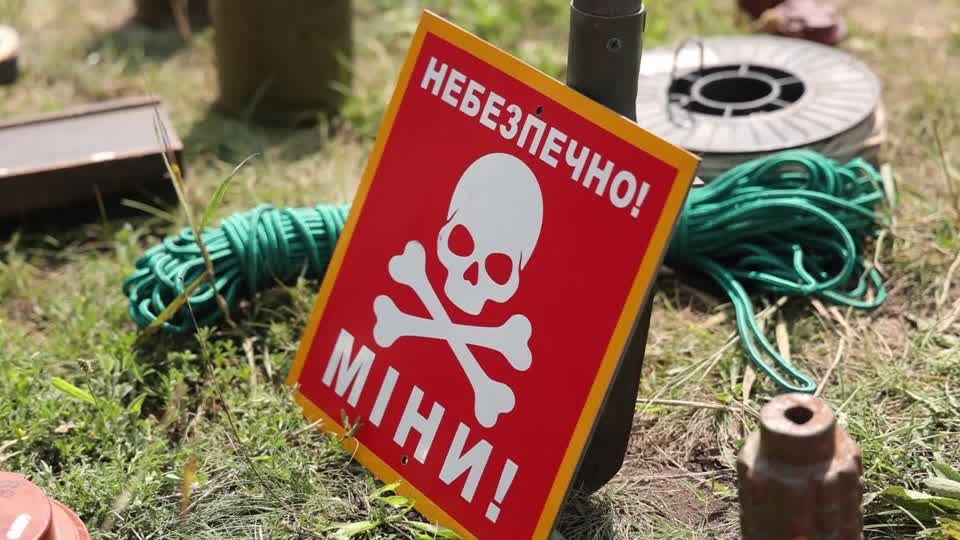
GERRY DOYLE, HAN HUANG and JACKIE GU, of Reuters, investigate…
As Ukrainian forces slowly push ahead with their 2023 counter-offensive after more than a year of shifting battle lines, the country’s military and civilians face a deadly problem: land mines, potentially hundreds of thousands of them, scattered across roads, buried in fields and concealed in devastated cities.
There are new, advanced types that can sense movement or destroy vehicles from hundreds of metres away. Most common, however, are older, simple weapons that were produced in the tens of millions and fill the armories of both the Ukrainian and Russian militaries.

An anti-tank mine is seen in the village of Neskuchne, recently retaken by the Ukrainian Armed Forces, amid Russia’s attack on Ukraine, near a front line in Donetsk region, Ukraine, on 8th July, 2023. PICTURE: Reuters/Sofiia Gatilova/File photo
Reuters interviewed four humanitarian demining organisations and two military experts and examined technical surveys by mine-clearance groups of unexploded ordnance in Ukraine to reveal mine contamination so vast that it is most likely unprecedented in the 21st century.
Because the conflict is ongoing, “there has been no empirical way to determine the area that has been contaminated” or the degree of contamination, said Mark Hiznay, associate arms director at Human Rights Watch. “Whatever the largest category you want to create, call it large, very large, severe, extreme…[Ukraine] would be in that category.”
“Whatever the largest category you want to create, call it large, very large, severe, extreme…[Ukraine] would be in that category.”
– Mark Hiznay, associate arms director at Human Rights Watch
Land mines have proved a formidable obstacle for Ukraine’s military, bogging down assaults during its counter-offensive and disabling armoured vehicles. Minefields in Zaporizhzhia and Donetsk oblasts have required large-scale combat engineering efforts, a difficult endeavour for even the best-equipped militaries.
As a result, Ukrainian forces have been forced to proceed at a deliberate pace, attacking Russian artillery and other fire support before attempting to create assault lanes with mine-clearing line charges and armoured vehicles with plows.
Militaries and humanitarian deminers use vastly different methods for mine decontamination, so even after Ukraine’s armed forces clear lanes through minefields and recapture territory, the risk to civilians persists – and may continue for decades.
“There are still communities interacting with [mines] every day…because they have to, as a matter of livelihood,” said Adam Komorowski, regional director for Eastern Europe, South America and the Caribbean at humanitarian deminer Mines Advisory Group. “Do I go out and take the risk that I might come across an explosive device? Or do I simply decide to not plant or harvest crops? Either way you’re making a horrific choice.”

Ukrainian mine experts scan for unexploded ordnance and landmines by the main road to Kherson, Ukraine, on 16th November, 2022. PICTURE: Reuters/Murad Sezer/File photo
One of the most common types found in the Ukraine war is the PFM-1 anti-personnel mine, known colloquially as a butterfly mine, which has a plastic body about the size of a paperback book. With only 37 grams of explosives, according to Geneva International Centre for Humanitarian Demining documents, it is not meant to create a large blast. Rather, when a person steps on one of the mine’s “wings,” it detonates in an explosion big enough to maim.
Used widely by the Soviet Union during its invasion of Afghanistan in the 1980s, such mines can be scattered by hand, by aircraft or by rocket artillery. Metal detectors can sense their metal parts, but the mines’ odd shape and size mean that they can lie unnoticed for years, and civilians can mistake them for harmless objects.
“They are very dangerous, especially for civilian populations,” said Tymur Pistriuha, head of the Ukrainian Deminers Association. “It is like a leaf…it is green. In grass it is difficult to identify this.”
The POM-3 anti-personnel mine, by contrast, is a new design that does not need to be touched to detonate. It also can be scattered by aircraft, rockets and artillery, righting itself after landing with small mechanical “petals”. The mine, about the size and shape of a soft-drink can, inserts a small probe into the ground. When the probe detects vibration – for instance, footsteps nearby – it launches the main mine 1 to 1.5m into the air, according to GICHD documents. At that point, the 100g explosive payload detonates, spraying deadly metal fragments. Because these mines are dangerous to even approach, one way to safely disable them is to shoot them from a distance, Hiznay said.
Anti-vehicle mines are also prevalent in Ukraine. Among the most numerous is the TM-62 series, which both the Russian and Ukrainian militaries have deployed. They can be placed on the surface or buried in shallow holes. The TM-62M is older and has a metal body, making it easier to detect, according to GICHD; the TM-62P3 has a plastic body. Both contain 6.5 to 7.5 kilograms of high explosives designed to blast upward through the weaker belly armor of a vehicle.
If a pressure fuze is installed, 150 kilograms of mass on the fuze is required to trigger it. Magnetic-influence fuzes sense any metal containing iron, such as steel, and detonate when it passes a certain threshold.
The German-designed PARM mine – short for Panzerabwehrrichtmine – is concealed near places where enemy vehicles are expected to pass. When it is triggered via a tripwire, infrared sensor or remote command, it fires a high-velocity rocket with roughly two kilograms of explosives shaped to blast through a vehicle’s armor. The Ukrainian military received more than 1,500 of them from Germany in 2022.
GICHD has documented at least 12 types of anti-personnel mines and nine types of anti-vehicle mines in use in Ukraine. Andro Mathewson, global research officer for HALO Trust, a humanitarian demining organisation, said the group’s experts had found at least 10 new types of modern mines, including the POM-3 and PARM series, in Ukraine.
The Ukraine war “is the first one I have worked in where we are dealing with a developed nation superpower as one of the present combatant armies”, Komorowsi said, referring to Russia. The “last time you had a nation of that power using land mines on any kind of industrial scale” was the Soviet Union in Afghanistan four decades ago, he said.
Militaries typically plan and map out minefields so that their own forces know where the danger is. That can make humanitarian demining easier. In Ukraine, most such minefields are around the line of contact, which runs through the country’s east from the border with Russia about 150 kilometres east of Kharkiv, south and west through Zaporizhzhia oblast to just south of Kherson city near the Black Sea coast. The line is thousands of kilometres long and the number of minefields along it has not been determined, Hiznay said.
“In the 1991 Gulf War, the Iraqi defensive zones the US Army breached through were two to five kilometres deep,” with tens of thousands of mines per minefield, said Mick Ryan, a retired major general in the Australian Army and a combat engineer. “What the Russians have done in the south in particular might approach something like that…we are talking in the hundreds of thousands at a minimum.”
We rely on our readers to fund Sight's work - become a financial supporter today!
For more information, head to our Subscriber's page.
In places where Ukraine has recaptured territory, the level of mine contamination is better understood. Formerly occupied towns in Kyiv; Sumy, Chernihiv, Mykolaiv and Kharkiv oblasts all saw a large number of mines, especially anti-personnel mines, left in place, Mathewson said.
That creates a situation where “everything is dangerous”, Pistriuha said.
“For example, we are still in liberated areas forbidden to go into forests during mushroom season,” he said. “Our authorities do not allow people to go into the forest to pick mushrooms, because it is still not clear of mines.”
Hiznay and Komorowski said anti-personnel mines and improvised booby traps presented a huge risk to civilians in these areas.
Nonetheless, most of the reported civilian land-mine injuries since the invasion have been related to anti-tank mines, Mathewson said. Between February, 2022, and May, 2023, HALO trust data show, 855 civilians were reported hurt or killed in 550 mine-related accidents.
“The most dangerous thing you can really do right now in Ukraine is drive on an unpaved road,” he said. “If you think about an anti-tank mine that is designed to take the treads off or disable a 30-ton tank, you can imagine what it does to a two-ton car.”
Mines’ military purpose is to hinder enemy movement, forcing vehicles and troops to avoid certain areas, spend time clearing mines or risk crippling casualties.
“Kill and maim enemy soldiers – at heart, that’s what these things do,” Ryan said. Over the winter, Russian forces repeatedly assaulted the Ukrainian city of Vuhledar, but the attacks were stalled by anti-vehicle mines, said Ryan and Jack Watling, senior research fellow for land warfare at Royal United Services Institute.
Armies don’t clear all mines when they advance. Instead they create lanes through which offensive forces can assault enemy positions, Watling said. Because of that, he said, they can use tools that are faster and more destructive, such as “line charges” – ropes of explosives that are fired into a minefield and detonated, triggering mines.
The faster that process is, the less time the assaulting force will be exposed to enemy fire, he said.
“The problem is not the mine,” Watling said. “The mines are an unpleasant harassing capability that can be dealt with if you have time. It’s mines covered with (enemy) fire — that is the problem.”
Watling and Ryan said other methods, such as plows or rollers mounted on armoured vehicles, could also be used depending on circumstances. Military minefields almost always contain a mix of anti-personnel and anti-vehicle mines to prevent infantry from advancing on foot.
Humanitarian demining is more painstaking. First, in cooperation with mine-action authorities in the country in question, workers will do a non-technical survey to learn about levels of contamination. That involves talking to communities, learning what they have seen, heard and experienced, and sifting through reports and records of battles and emplacements, Komorowski and Pistriuha said. Demining workers adhere to the International Mine Action Standards, a United Nations framework developed in the mid-1990s, augmented with national standards of the country in which they are operating.
Using survey information, experts will create polygons on a map showing areas of focus, Hiznay said. The next step is a technical survey, which involves searching for the edges of minefields using equipment such as ground-penetrating radar and metal detectors. Dogs and rats can be trained to detect the explosives in mines, the demining experts said. Surveyors mark the edges of the minefields and note what types of devices may be there.
At that point demining begins, with a priority placed on areas that are important to the local population, such as agricultural fields, water sources, urban areas and roads. There are two general types of clearance, Komorowski said, both involving highly trained workers in protective gear.
“One, no-touch mines. If you find those, you blow them in situ,” he said. “Two, a conventional anti-personnel mine is generally activated by pressure on the top. If you excavate it from the side and safely remove it and unscrew the fuse…you remove the explosive and it’s just an inert bit of plastic and metal.”
Once that is finished, before land is handed over for safe civilian use, “quality control” will be performed using different mine-detecting methods, he said.

A sapper of the State Emergency Service pulls an anti-tank mine as he inspects an area for mines and unexploded shells, amid Russia’s attack on Ukraine, in Kharkiv region, Ukraine, on 21st March, 2023. PICTURE: Reuters/Viacheslav Ratynskyi/File photo
The destruction in June of the Nova Kakhovka dam and resulting flooding in southern Ukraine has most likely displaced many mines along the Dnipro River’s left bank, creating more danger, HALO trust said.
Ukraine is a signatory to the 1997 Convention on the Prohibition of the Use, Stockpiling, Production and Transfer of Anti-Personnel Mines and on their Destruction, and had been destroying its anti-personnel mines when the war began. Human Rights Watch reported in January that it had found evidence that rocket-scattered PFM-1 mines had been used against Russian forces in Izium; Ukraine’s foreign ministry said at the time that the country’s forces strictly adhered to the convention and that the report would be “properly analysed by the relevant institutions”. Ukraine’s foreign ministry did not respond to a recent request for comment.
Russia, which is not a signatory, has widely used anti-personnel mines. Russia’s defence ministry did not respond to a written request for comment.
Militarily, Ukraine’s counter-offensive is trying to punch through Russian minefields. On the humanitarian side, non-technical surveying has begun, but working near the front is impossible. For now, demining organisations are trying to help civilians avoid danger and restore normalcy to everyday life.
“The scale of tragedy is tremendous,” said Pistriuha, who is from Kyiv. “That’s why we cannot solve this problem just by ourselves. Only the world community, our partners, can help us with support for humanitarian demining.”

Ukrainian sappers’ equipment as they train to clear mine fields. PICTURE: Video screenshot/Reuters
UKRAINE’S SAPPERS ADVANCE SLOWLY THROUGH RUSSIAN MINEFIELDS
Sappers fresh from the front conducted mine clearance drills in southeastern Ukraine this week, a task that is proving crucial but painstakingly slow as Ukrainian troops try to advance on Russian forces.
As they trained last Wednesday, the sappers outlined the challenges they faced on the battlefield, offering an insight into why the counter-offensive has so far progressed slowly.
Tasked with clearing tens of thousands of Russian mines, the sappers have to worry about booby traps, bombs and mortar attacks. Using a metal detector is often futile because of the amount of shrapnel from unexploded ordnance strewn around.
“They [the mines] are stalling the speed of the advance as we have to work very carefully,” said Oleksandr, one of scores of sappers training at a location in the southeastern region of Zaporizhzhia that Kyiv’s military told Reuters not to disclose.
Oleksandr, who uses the call sign Agronomist, said NATO standards allowed for one person to advance seven square metres within four hours.
“Can you imagine that? However, that’s not the case here.” he said.
Ukraine has recaptured a string of villages but no big towns since launching its counter-offensive in the Russian-occupied south and east in early June. President Volodymyr Zelenskiy has acknowledged progress has been slower than desired.
Russian President Vladimir Putin said on Thursday that Ukrainian attacks in the south had intensified. Hours earlier, Zelenskiy had touted “very good results” from the front, without providing details.
Before the counter-offensive began, Russian occupying forces on the southern front had time to dig trenches and put down “dragon’s teeth” barricades, anti-tank ditches and mines.
At the training drills, a 37-year-old soldier with the call sign “Adam’s Apple” wore special foreign-made blast boots for mine clearance.
“I don’t know which country manufactured them, but they are critically important for sappers because if one steps onto an anti-personnel landmine…the boots will save the sapper’s legs,” he said.
He said he sometimes has to use a stick to probe for mines, advancing slowly when there is so much shrapnel on the ground that using a mine detector is useless.
Before the probing begins, he said, sappers must survey the area while standing, lying down and kneeling.
“The perspective differs, depending on the height,” he said. “If there are no booby traps, the sapper will examine the soil around his feet with the mine probe. If no mine is detected, he will move forward while keeping probing the soil.”
– SERGIY CHALYI, Zaporizhzhia Region, Ukraine/Reuters






